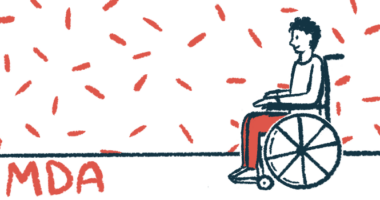Phase 3 Apitegromab Trial Planned for Non-ambulatory Types 2, 3

Scholar Rock plans to soon initiate a Phase 3 clinical trial of apitegromab, its investigational muscle-directed treatment for spinal muscular atrophy (SMA), in type 2 and 3 patients who are unable to walk.
“We anticipate initiating a Phase 3 trial to evaluate apitegromab in patients with non-ambulatory Type 2 and Type 3 SMA by the end of 2021 as we work towards our aim of establishing apitegromab as the potential first muscle-directed therapy to treat SMA,” Yung Chyung, MD, Scholar Rock’s chief medical officer, said in a press release.
The new study will build on positive top-line results from the Phase 2 TOPAZ (NCT03921528) clinical trial that evaluated apitegromab in children and young adults with SMA type 2 and type 3, both of which are later-onset forms of the disease.
Further details from the Phase 2 study were shared in a pair of posters presented at the World Muscle Society (WMS) Virtual Congress late last month by scientists at Scholar Rock and other institutions. The posters were titled, “Apitegromab in Spinal Muscular Atrophy (SMA): An Analysis of Multiple Efficacy Endpoints in the TOPAZ Trial” [LPB.10] and “Insights into the Potential Pharmacological Effects of Apitegromab in Health and Disease: Data from Preclinical and Clinical Studies.”
The TOPAZ trial, sponsored by Scholar Rock, enrolled 58 patients at locations in the U.S. and Europe. Participants were treated with one of two doses of apitegromab (either a low dose, 2 mg/kg, or a high dose, 20 mg/kg), given by infusion into the bloodstream every four weeks for up to one year. Most (83%) got the higher dose, and most (81%) were also being treated with Spinraza, the first therapy approved for SMA.
Motor function was mainly assessed via the Hammersmith Functional Motor Scale Expanded (HFMSE) and the Revised Hammersmith Scale (RHS). Higher scores on these tests indicate better physical ability.
Overall, 39% of participants experienced an increase in RHS scores of at least one point, and 22% an increase of at least three points over the course of the study.
In a group of 17 patients with type 2 SMA who started on Spinraza before age 5, mean HFSME scores increased by 7.1 points over the course of the trial among those treated at higher-dose apitegromab. In 63% of these higher-dose patients, the increase in HFMSE was at least six points.
Among 14 type 2 and 3 patients, ages 5 to 21, who were unable to walk, 64% of those on apitegromab at high dose experienced an improvement of at least one point in the HFMSE over the study’s course. Additionally, 29% had a three-point improvement in HFMSE scores.
Another measure that focuses on arm function, the Revised Upper Limb Module (RULM), also was used to assess nonambulatory participants. Marked improvements on this score were again seen for those given the higher dose of the investigational medicine.
Analyses also showed that greater improvements were generally reported in patients with less advanced disease, who did not have scoliosis or joint contractures.
“These additional analyses from the TOPAZ Phase 2 trial further reinforce our enthusiasm for the potential of apitegromab to improve motor function for patients with SMA, and provide exploratory insights in both the ambulatory and non-ambulatory populations,” Chyung said.
Apitegromab works by blocking the activity of myostatin, a protein that acts to slow muscle mass growth. Notably, this mechanism of action is distinct from currently approved disease-modifying therapies for SMA, all of which aim to increase levels of the SMN protein.
“Apitegromab has the potential to be the first muscle-directed therapy to address motor function impairment affecting patients with SMA,” the researchers concluded.








